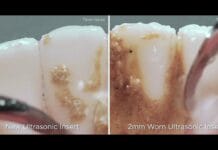An emphasis on the importance of dental health has increased the number of children seeking dental visits. A study conducted in 2014 reported that 64.6% of children under the age of 18 visited their dentist every six months.1 This statistic increased to 84.6% in another study conducted in 2017.2
Implementing a successful pediatric visit will often encourage children and their parents to continue with future dental treatment. Some important factors to achieving a positive dental experience for parents and their children are the initial contact, the patient’s comfort level, and the positive reinforcement of dental hygiene in the children’s lives.
When working in pediatrics, most hygienists have both good and bad interactions with patients. Clinicians can learn from either type of appointments, creating more positive experiences for apprehensive, new, or returning child patients. Several critical factors should be considered when treating children.
The Meet and Greet
When the clinician initially enters the reception area, parents should be addressed first, with an introduction of the clinician’s name and title. Following the greeting to parents, the clinician should either sit in a chair or kneel before the child. Facing the child at the same eye level will help put the patient at ease and eliminate the appearance of the clinician being dominant.
First impressions last a lifetime for the clinician and the child. After introductions are over, the clinician should ask the child about a toy or stuffed animal, an article of clothing, or some other personal object associated with the patient. This personal inquiry is a great icebreaker and will help ease the tension. This also allows the clinician to assess the child and determine his or her apprehension level before taking the child back to the operatory.
The Operatory
One important aspect of the appointment is how the clinician is perceived by the pediatric patient. Determining if the appointment will proceed with or without the parents present will depend on the child’s age and the child’s anxiety level at the meet and greet. If a child is school age, then moving forward to the operatory without the parents is recommended.
Explain to the parent that radiographs will be taken and the parents cannot be present in the room. The parents can join the child during the doctor exam. This discussion will prevent any ill feelings the parent may feel from not being present during treatment. Building a positive rapport with the child is almost always more successful without the parent present. Typically, parents like to interject directions during the appointment, and this can interrupt the relationship between the clinician and child.
However, children under school age will most likely need their parent present. The clinician should explain to the parents that in order to build a positive relationship with their child, the parents being seen but not heard is the best solution for achieving this goal. Parents can be a great asset to the appointment by assisting their children in the chair, especially if a knee-to-knee position is applied.
Look, Touch, Smell, Tell
The chair can be very threatening to the child, especially when the patient is moved into a supine position. Initially explaining the chair’s movements and comparing it to an amusement park ride can create a positive visual.
However, for the younger child, a knee-to-knee position with the parent is integral for an effective appointment. The child may cry while reclined on the clinician’s lap, but the clinician benefits by seeing into the oral cavity for an examination, prophylaxis, and fluoride application, if warranted. At the end of the appointment, the child will understand that no harm was done, and the tears will vanish.
Initially, handing children toothbrushes to demonstrate how they brush their teeth is important to reduce any anxiety. Asking children key questions, such as “How many times a day do you brush?” “Who brushes your teeth?” “Do you floss/clean in between your teeth?” “Do you know what causes cavities?” and “What kinds of food and drinks do you eat/drink at home?” These questions help the clinician understand the child’s at-home habits. Also, have the child allow the clinician to brush the child’s teeth to further the positive patient-clinician relationship.
Introducing the instruments to children and allowing the children to feel and hear the instruments prior to treatment can reduce the patients’ fear of treatment. Naming the instruments, such as calling the suction “Mr. Thirsty” or the explorer a “Tooth Fairy Counter” can create a playful nature to the appointment.
Demonstrating using instruments on the children’s fingernail will reduce any anxiety when these same instruments are introduced into the children’s mouths. Furthermore, allowing the children to choose and smell the flavor of the prophy paste will further relax them and involve them in the process. In order to prevent confusion, clinicians should offer a maximum of three prophy paste options.
Lastly, allowing the children to be active participants by having them apply the suction or hold a hand-held mirror to watch the procedures is very effective. Children are curious by nature, so allowing them to be active participants during their appointment will ensure a positive, thorough appointment.
The Doctor Exam
Now that the clinician has built a positive, trusting relationship with the pedo patient, introducing the doctor to the patient is as important in preventing any threat children may perceive. Also, allowing the parents to accompany children during the doctor’s exam will make children feel safer in the company of this unknown adult. In addition, the clinician’s praises about the child for a job well done will foster pride among parents.
The clinician should also remember never to leave the child unsupervised in the operatory. A brief explanation to the doctor of what was accomplished at the appointment is important information for the doctor’s examination.
The Fluoride Treatment
The fluoride application can be the most difficult part of the child’s appointment. First, any child who has had the fluoride treatment typically remembers the taste and sticky texture. Secondly, the bond between the child and clinician has been interrupted by the doctor’s examination, and now the clinician has to re-enter the mouth. Lastly, many parents are aware of the negative publicity surrounding the fluoride and may not remember about the positive impact fluoride can have on caries prevention.
To address these issues, the clinician should first receive permission for the fluoride application from the parents. This will allow the clinician to address any concerns or questions the parents may have regarding fluoride. The American Dental Association (ADA) recommends children ages six or more have 2.26% fluoride varnish or 1.23% fluoride (APF) or ages six and under have 2.26% fluoride varnish applied during their bi-annual dental visit.3
Next, having the fluoride available on a glove or finger for the younger children will enable the doctor to dab the fluoride with a gloved finger for a quick application. If this is not an option, the readiness of the fluoride will allow the clinician to apply it while the child is still in an examination position.
For older children, explaining a tooth vitamin is going to be painted on the tooth will ease the application process. Furthermore, giving older children a flavor option is also effective. However, most children do not like the taste or sticky texture of fluoride; therefore, moving on to the “goody bag,” sticker, or toy may be necessary.
Concluding the Appointment
After the completion of the appointment, praise the child, and review any concerns or treatment needs with the parents. Concluding with some important dental and dietary information will help ensure a positive, healthy appointment in six months.
Although these tips are effective, it is important to understand “the one size fits all” model does not apply here. Applying the above techniques and then tweaking where needed will help to ensure a positive patient-parent-clinician relationship.
References
- Health Policy Institute. (2019). American Dental Association. Retrieved from www.ADA.org/en/science-research/health-policy-institute/dental-statistics/patients
- Oral and Dental Health Data for the US. (2017). Centers for Disease Control and Prevention. Retrieved from cdc.gov/nchs/fastats/dental.htm
- Professionally-applied and prescription strength, home-use topical fluoride agents for caries prevention clinical practice guide. (2013). American Dental Association. Retrieved from https://ebd.ada.org/en/evidence/guidelines/topical-fluoride












